Menus
- Export hit
- Two-cylinder almost indestructible
- Closely related to the 750
- Around 20 km / h higher top speed and more bite on high tours
- Reduced dynamics
- The muffled hammering of the two-cylinder reaches the ear
- It’s the inner values that count
- Technical data and further information
- Facelift Suzuki GS 400
- Frank Lutz’s opinion
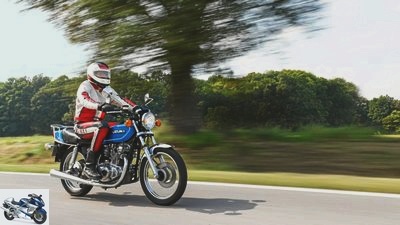
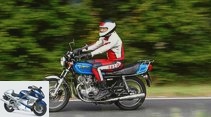
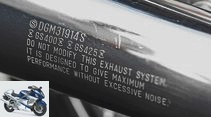
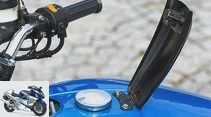
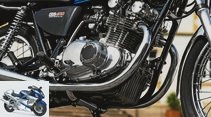
18th photos
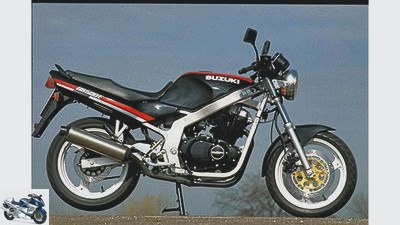
1/18
1989: Drilled to 487 cm³, the GS 500 E starts with 46 HP. Its two-valve engine is also based on that of the GS 400. It becomes a top seller that will last until 2004. Price 1989: 6,540 marks.
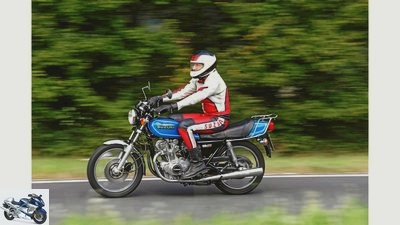
2/18
Suzuki GS 400.
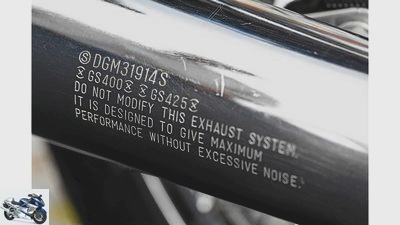
3/18
Reading educates: There are no more questions unanswered as to what the purpose of an exhaust is.
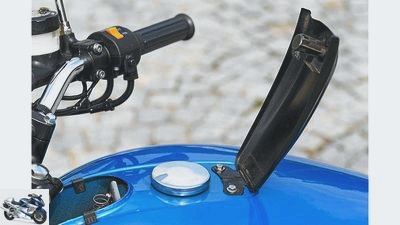
4/18
Closure thing: The tank cap is hidden under a cover.
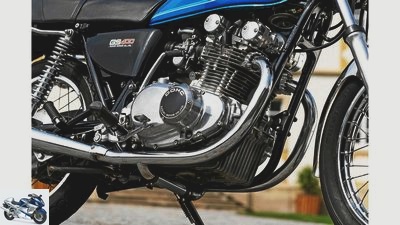
5/18
A nice piece of technology: With its first four-stroke engines, Suzuki perfectly understood how to pack the extremely stable mechanics in a particularly attractive way.
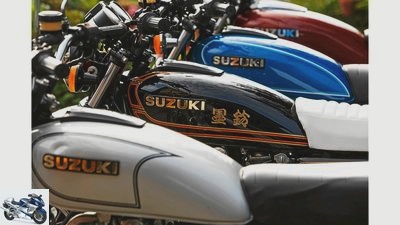
6/18
Rare style life: You can hardly find such a colorful variety of GS 400 today.
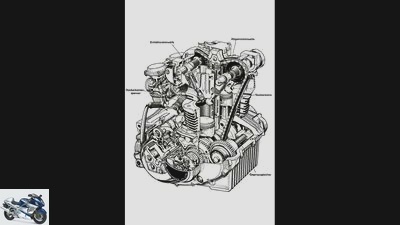
7/18
… We’d rather praise the exact representation of the two-cylinder in the official workshop manual, which gives a good insight into the robust technology.
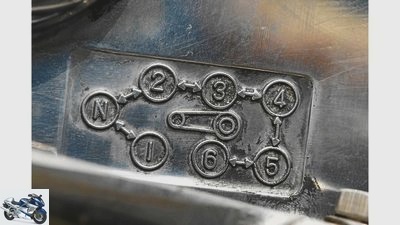
8/18
Limited symbol power: The circuit diagram shown in the left engine cover is more of a confusion …
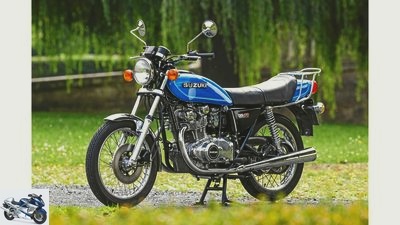
9/18
Suzuki GS 400.
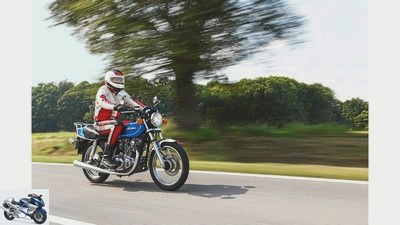
10/18
Sometimes her name is Margarethe, sometimes she is just called Maggy. Anyone looking for a Suzuki GS 400 in the vastness of the Internet will almost inevitably come across it at some point.
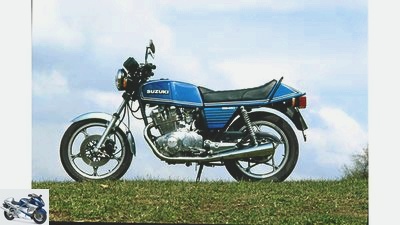
11/18
1980: Replacement of the GS 400 by the GS 450 E. Radically different styling, hardly changed chassis. The motor is now shorter-stroke and has a crank mechanism with slide bearings. Price: 5,151 marks.
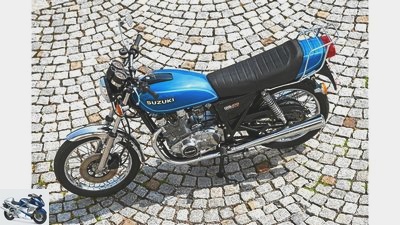
12/18
Suzuki GS 400; Price 1978: 4,850 marks.
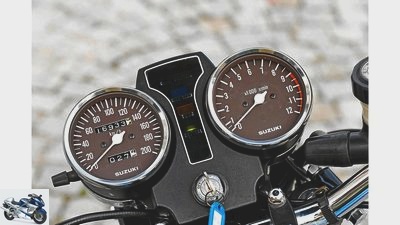
13/18
… replaced by a simpler one with six lamps.
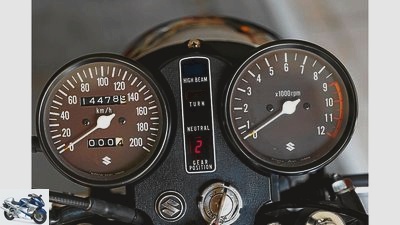
14/18
Rationalization: Most of the changes were aimed at lowering production costs. This is how the seven-segment gear display of the first models became …
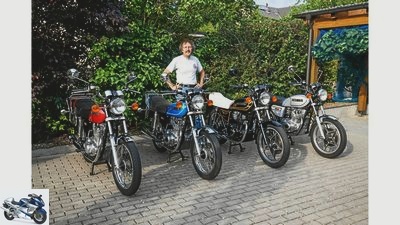
15/18
Frank Lutz about the Suzuki GS 400: I got stuck with the GS 400 30 years ago because the pretty exterior of Suzi turned my head.
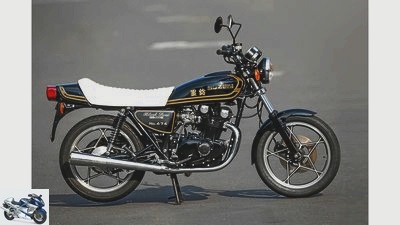
16/18
GS 400 E “Black Suzi”: With the exception of the black paintwork with the striking characters and numbering, the engine, which is also in black, and the white seat, the “Black Suzi” corresponded to the standard model – even in terms of price!
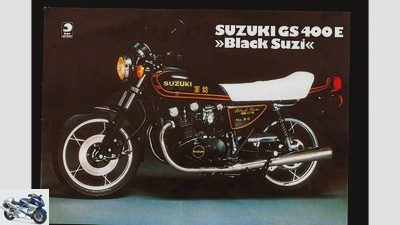
17/18
As one of the first manufacturers, Suzuki recognized in 1979 the sales-promoting effect of a limited special model.
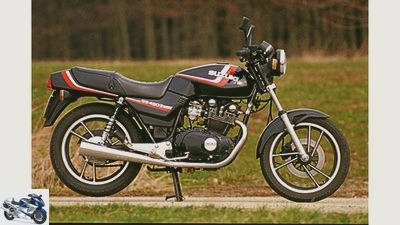
18/18
1988: Suzuki digs out the two-valve engine again and places it in the chassis of the GSX 400 – the GS 450 E / S with 27/42 hp is ready. Price: from 5,319 marks.
On the move with the Suzuki GS 400
Export hit
Content of
The Suzuki GS 400 once conquered the hearts of motorcyclists in this country too, and for many it was the first “real” machine. Today, however, the small Suzuki is one of our rarities. Thousands were shipped back to Japan because the 400 series is now cultivated in their homeland.
Sometimes her name is Margarethe, sometimes she is just called Maggy. Anyone in the vastness of the Internet looking for a Suzuki GS 400 searches, almost inevitably comes across them at some point. And other seekers. Only for seekers. Because the market in Germany, yes in all of Europe, has largely been grazed, the GS 400, with us once the “bread and butter” motorcycle par excellence, has disappeared. Secretly, quietly and quietly.
Buy complete article
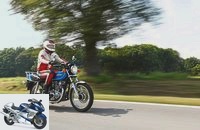
On the move with the Suzuki GS 400
Export hit
Frank Lutz owns seven Suzuki GS 400
Frank Lutz, who owns seven Suzuki GS 400s, also thinks. And would not part with its treasures for any money in the world. Even at the time of great hunger for performance, the Franconian discovered that bread and butter can fill you up if you get it served as tasty as Suzuki’s little four-stroke twin.
It was exactly 30 years ago that the radio and television technician bought his first used Suzuki GS 400 – for very little money, as he remarks with a smile today. As he had already drilled several times before, he wanted to crack open and sell the somewhat battered 1976 model in order to finance his motorcycle hobby. But he got stuck with the Suzuki, succumbed to its beauty. “The GS 400 is an incredibly aesthetic motorcycle for me, the timeless and extremely harmonious lines still inspire me today. A dream, especially with a chrome mudguard and wire wheels! “
All articles about the Suzuki GS 400
Two-cylinder almost indestructible
It was the beginning of an intense passion that has remained unbroken to this day, as you can easily see when you look into the 52-year-old’s garage. There the seven Suzuki GS 400 share the space not only with various other Suzuki GS and GT models, but also with countless spare parts and engines that the Suzuki fan has accumulated over the years. Or rather, saved from scrapping. “At that time, nobody was interested in these motorcycles, they were typical utility and consumption motorcycles that I often bought for a few marks, even parts were dirt cheap,” recalls Frank.
He cannibalized around 25 to 30 machines, more than enough to cover his needs, especially since the technology of the two-valve two-cylinder has proven to be extremely solid. “A Suzuki GS 400 runs forever, the design of the two-cylinder is actually oversized and almost indestructible”, Frank knows from his many years of experience.
Closely related to the 750
In 1976, Suzuki wanted to be on the safe side. After all, the Suzuki GS 400 was only the second four-stroke motorcycle from the Japanese manufacturer after the four-cylinder 750 that had been presented shortly before, and in this respect it clearly lagged behind the competition. So the first serve had to be perfect to stay in the game. It was a perfect fit. Both the much-praised 750 and the 400, whose elaborately made twin had a lot in common with the robust four-cylinder.
The lavish technology package with two overhead camshafts, roller bearing crankshaft drive and balance shaft was of course not available at a dumping price. In the first few years, the Suzuki GS 400 was always a tad more expensive than the Japanese two-cylinder competition in the 27 hp class, which was very popular at the time, because it was low-insurance. The GS 400 only fitted into the latter from spring 1977, when Suzuki cut seven of the original 34 hp with tamer camshafts. At that time, Suzuki offered owners of earlier models the option of free throttling in exchange for the 34 hp camshafts. But if you wanted to keep them, you had to pay the installation costs in full.
Around 20 km / h higher top speed and more bite on high tours
Frank saved himself this hassle with his first Suzuki GS 400. The reward: According to the MOTORRAD measurement (issue 9/1977), the top speed is around 20 km / h higher and more bite on high tours. I don’t get to feel it though. For the photos I chose a completely original 27 hp copy from Frank’s collection. He customized his original GS a little back then. “Thirty years ago it was even more interesting than a perfect original condition,” he comments calmly on my decision.
And advises me to take a bit of serenity as I swing into the comfortable saddle of the blue Suzuki GS 400, which comes from the 1978 vintage. He, too, knows that 27 hp won’t knock anyone off their feet these days. To my surprise, however, the throttling measures are more likely to affect my prejudice than driving pleasure. However, it took me a while to get involved with the smooth, even performance characteristics of the two-cylinder.
Reduced dynamics
Especially on wide, well-developed federal highways or even motorways, on a 27-horsepower motorcycle like this you can clearly see how fast the traffic has become today. However, the narrower and more angular the routes, the sooner one learns to appreciate the even power delivery of the Drossel-Suzi. The Suzuki GS 400 doesn’t really care in which gear it is driven through the Winkelwerk, even in the sixth there is unshakable, jolt-free propulsion from 2500 tours – or 45 km / h. Its intensity alone can be varied via the precise and easily shiftable gearbox, whereby the perceived range extends from the stoic “I can still do it” in the highest level to a gentle slap in the bottom in third gear.
So I can calmly concentrate on the trivialities that come to the fore with increasing drive. For example, the impressive running culture. Well, you won’t be completely spared the tingling sensation, but the balance shaft does a great job. The mechanical smoothness of the almost 40 year old construction is also remarkable. The spur gear drive of the vibration inhibitor also contributes to this, as does the fact that, with the exception of the crankshaft and timing chain, only gears rotate in the horizontally divided engine housing. Banging chains, annoying rattling noises? Doesn’t exist on the Suzuki GS 400.
The muffled hammering of the two-cylinder reaches the ear
Above all, the muffled hammering of the two-cylinder Suzuki GS 400 reaches the ear, with a 180 degree crankshaft offset, but without a spectacular note. However, that fits this tamed drive, whose flat torque curve between 2500 and 7500 tours delivers 90 percent of the maximum torque (27 Nm).
The reliability and stability of the twin make more impression. “The crankshaft drive and gearbox are
indestructible with the Suzuki GS 400, these components last forever, ”Frank praises the designers. The MOTORRAD testers once had this impression after dismantling the endurance test machine (edition 23/1978), where only the slack oil control rings were noticed – but not a typical problem in Frank’s experience. The Suzi’s driving behavior is also characterized by a lack of problems. Its 27 hp never embarrass the sturdy double loop frame. Sit on it and feel good – these are the first thoughts that my personal hard drive has saved. Relatively compact posture, comfortable knee angle, comfortable bench, suspension that is easy to swallow – that fits, even for long distances.
Even with a slight pull on the handlebars, the Suzuki GS 400 willingly folds into an inclined position and, with its narrow soles, cannot be taken off course even by bumps, although the relatively weakly damped spring elements on bumpy roads sometimes bring more momentum to the action than it should be. Thicker oil, tighter cones – and that would be the end of the subject. Especially since the needle-bearing swing arm (initially even with grease nipples!) Offers the best prerequisites for permanently precise driving behavior – even on this point, the Suzuki justified its higher price compared to the competition. The brakes are up to the mild temperament at any time, although if I were Frank I would probably experiment a little with the front pads to find more snappy ones for the individual disc. The rear drum, on the other hand, works like the whole motorcycle – very solid.
It’s the inner values that count
I make a little detour, a few kilometers detour alone through the curvy green of the Steigerwald, following the permanent change of light and shadow. Without stress, without hectic rush and without jostling traffic, I let myself go and let my thoughts wander. And at some point I notice that little Suzuki has actually managed to infect me with her equanimity! Would she always succeed? I dont know. It is now clear to me, however, that throttle machines do not automatically have to be pleasure killers. And that the harmonious charisma of the Suzuki GS 400 is not limited to the pretty exterior.
Frank nods vigorously. After 30 years with the Suzuki GS 400, the technician and mechanic knows best that for such a passionate relationship, of course, the inner values are particularly important. Whether for Maggy too & Co. count? I have my doubts about that.
Technical data and further information
Suzuki GS 400.
Technical data (type Suzuki GS 400 C)
Engine: Air-cooled two-cylinder four-stroke in-line engine, two overhead camshafts, two valves per cylinder, actuated by bucket tappets, displacement 398 cm³, output 20 kW (27 PS) at 7400 rpm (optionally 25 kW / 34 PS at 8500 rpm)
Power transmission: multi-disc oil bath clutch, six-speed gearbox, chain drive.
Chassis: Double loop frame made of tubular steel, telescopic fork at the front, Ø 33 mm, two-arm swing arm with two spring struts, wire-spoke wheels, tires 3.00 S 18 at the front, 3.50 S 18 at the rear, disc brake at the front, Ø 270 mm, single-piston floating caliper, simplex drum brake at the rear, Ø 180 mm.
Dimensions and weights: wheelbase 1385 mm, weight 185 kg with a full tank
0-100 km / h: 7.2 s
Vmax: 144 km / h (unthrottled: 166 km / h)
technology : The close relationship between the 400 two-cylinder and the 750 four-cylinder was not a coincidence, but also corresponded to commercial considerations. This was the only way to justify the high technical effort with which the Suzuki GS 400 clearly outperformed the competition on its debut in 1976. Like the four-cylinder, the two-valve twin with a 180 degree crankshaft offset has a horizontally split engine housing in which a five-part crankshaft rotates in three roller bearings. With the exception of the two overhead camshafts driven by a timing chain, only gears are used in the engine for power transmission; the balance shaft rotating at the same speed in front of the crankshaft is also driven by a spur gear set.
In contrast to the 750 series, the primary drive in the Suzuki GS 400 is via helical gearing. On the other hand, pistons (Ø 65 mm), timing chains with guides and tensioners as well as the valves with spring plates, wedges, bucket tappets and shims are identical. The timing chain is guided by two plastic-coated slide rails and a roller between the camshafts, the rear one is pressed by the automatic chain tensioner with spring-loaded push rod and locking pin. Power is transmitted by a multi-plate oil bath clutch and a dog-shift gearbox, which with six gears has one more than its counterpart in the larger-capacity four-cylinder.
Purchase check: The Suzuki GS 400 was consumed as an inexpensive everyday vehicle for decades. When buying, the following applies: No illusions, there are no longer well-groomed first-hand pearls. Likewise, there are no real weak points, the crank mechanism and gearbox are oversized and good for very high mileage. Damage? Practically unknown. Pistons, cylinders and valve train also last well over 100,000 kilometers, depending on the driving style. On the other hand, the automatic timing chain tensioner with a leaking shaft seal (10x16x4) causes problems more often..
In addition, the ball of the mechanism works its way into the inclined plane, then the automatic readjustment no longer works, noticeable by the rattling of the timing chain. Leaks are also known from the shaft sealing ring on the ignition side when it hardens. However, like the other shaft sealing rings, it can be changed from the outside without dismantling the motor. Caution: Most Suzuki GS 400 are factory-fitted with a foot seal one millimeter thick (27 hp version). On the market (and in all accessory sealing kits) only the seal of the unthrottled version is available, which measures only 0.6 millimeters. If this is installed without grinding out the slight “shoulder” at the reversal point of the piston rings, there is a risk that the rings will hit this “edge”, which means that the piston ring groove will deflect and break in a very short time.
If you want to be on the safe side, it is best to use two foot seals (this results in 1.2 mm). When it comes to the supply of spare parts, the following applies: technology is still available, many of the successor models also fit here. The pistons are identical to the GS 750, valves and guides were still used in the GS 500 E. There are generally no longer any add-on parts, not even exhaust systems, not even from the accessories. Today, a Suzuki GS 400 can also be dethrottled with the 42 hp camshafts of the GS 450; a further increase in performance is possible by boring out the cylinders using pistons from the GS 850 with a 69 millimeter bore.
Market: Which market? The search ads, mostly from professional exporters, clearly outweigh them, who pay around 800 to 1000 euros for hijacked Suzuki GS 400. However, there is practically no offer in this country. Still, the prices don’t skyrocket too much. If you are lucky enough to find a good copy, you have to expect claims between 2500 and 3500 euros.
Specialists:
Rainer’s father
Telephone 074 57/2070,
www.motorrad-vater.de
Internet forums:
www.suzuki-classic.de
www.suzuki-gs.de
www.gs-classic.de
www.suzukicycles.org
Facelift Suzuki GS 400
1989: Drilled to 487 cm³, the GS 500 E starts with 46 HP. Its two-valve engine is also based on that of the GS 400. It becomes a top seller that will last until 2004. Price 1989: 6,540 marks.
Here Frank has listed the most important changes in the GS 400 vintages. His favorites are the first models: “The Suzuki GS 400 had no teething problems, was best made and equipped in 1976/77. Almost all subsequent changes were therefore aimed primarily at savings in manufacturing costs. This is particularly evident from 1979 onwards, when the quality of the paint and weld seams has clearly decreased. ”
1976/77: Suzuki GS 400 B (chassis number: GS400-10001 to 30705). Colors: Stardust Silver Metallic, Candy Calypso Red, Andes Blue Metallic without tank decor. Black side covers, two-part brake discs, riveted (6.7 mm thick). Chrome-plated fittings with black cover below, digital gear display with seven-segment display, two-part exhaust system without interference pipe, rigid driver footrests, grease nipple on the swing arm, access to the oil pump strainer via a separate cover on the underside of the engine. Handlebar switch made of aluminum, chrome-plated starter cover, seat bench cover with longitudinal stripes, throttling from 34 to 27 hp only via camshafts. Suzuki GS 400 XB: like Suzuki GS 400 B, but with drum brake of the T 250 in the front wheel, without starter.
1978: Suzuki GS 400 C / EC (chassis number C: GS400-30705 to 58411, EC: GS400-500001 to 502463).
Colors: Black, Candy Florida Blue, Stardust Silver Metallic, Marble Straight Red, Pure White with narrow decorative stripes on the tank. Changes compared to B: One-piece brake disc (6 mm), black fittings with chrome-plated lower cover, oil pump strainer no longer accessible from the outside, new 2-in-2 exhaust system with interference pipe, manifold and exhaust now welded, handlebar switch made of plastic, starter cover painted in silver, In the course of the model year, the gear indicator was switched to individual lights, no grease nipple on the swing arm, changed front wheel hub, changed wiring harness. Throttling to 27 HP via other camshafts and thicker base seal. EC: cast wheels, rear drum brake, Ø 160 instead of 180 mm.
Order individual issues of MOTORRAD CLASSIC
1979: Suzuki GS 400 N / EN (chassis number N: from GS400-58412, EN: GS400-502494 to 505115).
Colors: Black, Straight Blue, Marble Straight Red with wide decor. Changes compared to C: side cover painted in tank color, folding driver footrests, different indicators, headlights with narrow chrome ring, seat cover with diamond pattern, gold-colored lettering. GS 400 EBN “Black Suzi”, chassis number: GS400-503972 to 504471 (own research, there are no official details). Color: Black, bench white. Technically no differences. GS 400 L Softchopper, chassis number from GS400-700001, officially not imported, not to be confused with the GS (X) 400 L, which was sold from 79. Only a few copies built.
1981: Suzuki GS 400 ET (chassis number: from GS400-505116 to 505xxx, I have not yet seen a frame number 506xxx). Color: Stardust Silver Metallic with thin, black decor. Technically hardly any differences to the GS 400 EN. Fork changed, identical to the GS 450 / GSX 400, lettering “GS 400” on the side cover now as a plastic emblem, no longer as a sticker.
Frank Lutz
Frank Lutz’s opinion
Frank Lutz about the Suzuki GS 400: I got stuck with the GS 400 30 years ago because the pretty exterior of Suzi turned my head.
Frank Lutz about the Suzuki GS 400
I got stuck with the Suzuki GS 400 30 years ago because the pretty exterior of the Suzi turned my head. It’s a timeless, very harmonious design that always inspires me to see how the drop tank, seat and rear bumper take up the swing of the exhaust system. As a screwdriver, I am also impressed by the extremely robust construction of the two-cylinder.
Of course, it also played a role that both motorcycles and parts were very cheap back then. It’s a shame that the Suzuki GS 400 has almost completely disappeared from the streets with us, in good condition it is an absolute rarity today.
Related articles
-
Driving report Suzuki TL 1000 S
Driving report, Suzuki TL 1000 S Suzuki TL 1000 S. The TL 1000 S is intended to break the Italian supremacy among large-volume two-cylinder engines and…
-
Blacksmith Suzuki M 1800 R Intruder Endurance test interim balance Cast off for a long-term trip with the Über-Cruiser, which has the thickest pistons in…
-
Suzuki RG 500 and Suzuki GSX-R 750 in comparison
MOTORRAD CLASSIC on the move: Suzuki sport motorcycles 1984 Competitors: Suzuki RG 500 and Suzuki GSX-R 750 Content of Suzuki presented the…
-
On the move with Suzuki GT 750 and Suzuki GS 750
fact 37 pictures www.factstudio.de 1/37 With the GT 750 and GS 750, Suzuki had two attractive alternatives in its range, … www.factstudio.de 2/37 The cockpit …
-
Comparison test Ducati Monster 797 and Suzuki SV 650
Artist 28 pictures 1/28 Ducati Monster 797 and Suzuki SV 650 in the comparison test. 2/28 Ducati Monster 797: Modern, the first: The …
-
Comparison test Suzuki SV 650, Honda CB 650 F, Kawasaki ER-6n, Yamaha MT-07
www.bilski-fotografie.de 34 pictures www.bilski-fotografie.de 1/34 They are the hottest candidates among the middle class naked bikes ….
-
18 pictures 1/18 1989: Drilled to 487 cm³, the GS 500 E starts with 46 hp. Its two-valve engine is also based on that of the GS …
-
Driving report Suzuki GSX 750 Branded butter It’s much more than just a good bread and butter bike: With the GSX 750, Suzuki presents a solid all-round…
-
Suzuki GSX-R 750 – The super sports car in the three-quarter liter class
Bilski 14th photos Manufacturer 1/14 1998 – Injection system, steering damper, unbelievable 135 hp, reduced gear ratio, torque-increasing manifolds….
-
Old versus new: Suzuki, Honda, BMW
Old versus new: Suzuki, Honda, BMW Root system Even if today’s racing cars seem to have nothing to do with their ancestors, they still carry on certain…